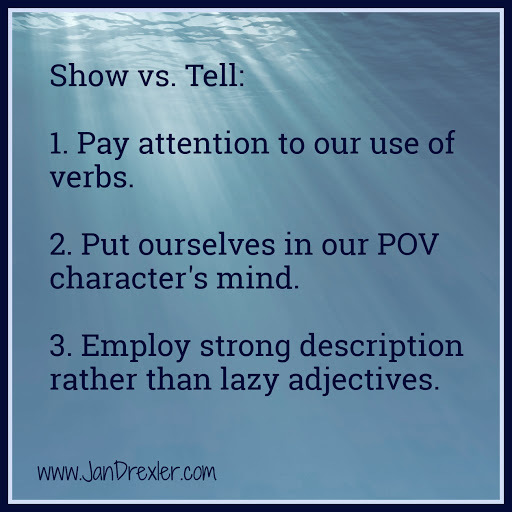Show vs. Tell: Clearing Up the Mystery
by Jan Drexler

You’ve heard that advice before, right? If there are rules for writing, this one has to top the list.
But while contest judges and critiquers (and other experienced authors) are fond of tossing this bit of advice our way, we rarely know exactly what it is that they’re talking about. It’s like the advice to “develop your voice.” Why is it so hard to pinpoint what it means?
In my opinion, it’s because “show, don’t tell” is a subjective technique of writing. Grammar, spelling, punctuation, paragraph structure…all of those are objective. I can tell you “A. B. C.” and you understand.
However, some writing techniques are more art than science. More right brain than left.
So, when someone writes on our darling manuscripts, “show, don’t tell,” what do they mean? And how can we fix it?

Let me give you an example. This excerpt is from my work in progress before I revised it:
I turned my rental car into the driveway of Rose’s Sweetbriar Inn and parked on the cement pad in front of the double garage doors. I got out and inhaled the tangy aroma of pine. Lovely. It reminded me of the time I had spent working in Norway three years ago.
But the Sweetbriar Inn was nothing like the hotel north of Oslo. That one had been made of steel and glass. Very modern. The Sweetbriar was a huge log structure that had been built against the base of the pine-covered hill that rose behind it. Rustic and secluded.
In case you’re wondering, this excerpt is ALL TELLING!
How do I know?
Look at the first sentence: I turned my rental car into the driveway of Rose’s Sweetbriar Inn and parked on the cement pad in front of the double garage doors.
It tells what happens. Emma (the main character) drives her rental car to the Sweetbriar Inn and parks in the driveway.
It’s very simple. Short and sweet. It conveys the action, but no more.
Now look at the rest of the excerpt. Same thing. There is some description, a hint of Emma’s backstory, and I’ve used, let’s see, two of the five senses. Not bad.
But it could be So. Much. Better.
How? By “showing” instead of “telling.”
Here’s my most recent draft of those two paragraphs:
As soon as I opened the door of my rented sedan, a familiar aroma tugged at my memories. Norway. Spring. Three years ago.
But the inn rising in front of me was nothing like the executive resort north of Oslo. Built into the side of a picturesque fjord, that building had been a steel and glass intrusion among the pines of the pristine Nordic wilderness. Sweetbrier Inn tucked its comfortable log structure into the embrace of the pine covered mountain deep in the Black Hills of South Dakota. Private. Secluded. Safe.
As we compare the two excerpts, we can pick out certain words that scream “telling.” I’ll highlight them:
I turned my rental car into the driveway of Rose’s Sweetbriar Inn and parked on the cement pad in front of the double garage doors. I got out and inhaled the tangy aroma of pine. Lovely. It reminded me of the time I had spent working in Norway three years ago.
But the Sweetbriar Inn was nothing like the hotel north of Oslo. That one had been made of steel and glass. Very modern. The Sweetbriar was a huge log structure that had been built against the base of the pine-covered hill that rose behind it. Rustic and secluded.
Every word I highlighted is a verb. Do you see that? Turned. Parked. Got out. Inhaled. Reminded. Was. Was. Had been built (passive voice – very “telling!”)
I’m not saying we shouldn’t use verbs, but the WAY we use them are key to whether our writing is strong “showing,” or weak “telling.”

The secret? Trade in your tired, weak verbs for strong and robust ones.
Look at the verbs I used in the second example: Opened. Tugged. Rising. Pasted. Tucked.
Not every verb is a strong one, but we’re not writing purple prose here. We want to use strong verbs, but we want to use them sparingly. We want to make them count.
Let’s try another excerpt. This one is from "The Roll of the Drums," my October 2019 release from Revell.
Here’s the pre-revisions and edits version:
The hungry horses fought for the grain, Delilah finally shoving Samson aside with bared teeth and thrusting her nose into the bucket.Before you go on to read the final draft of the sentences, read the first version again. What would you change to make this into a “showing” sentence instead of a “telling” one?
Remember – look for the verbs. How can you make them stronger?
Here’s another hint: When I’m editing sentences like this, I try to picture the scene in my mind. Where are my characters? What is the light like? The odors? What is my character’s state of mind and his focus?

When I rewrote this scene, I closed my eyes. I put myself in the barn, in Gideon’s place. What was he experiencing?
Samson whickered deep in his throat and extended his jug head toward the wooden scoop. The horse’s nostrils opened wide as he breathed in the scent of the grain before Delilah shoved him aside and reached for the oats with bared teeth.And another hint. Read the two examples again. In the first one I used the adjective “hungry.” Do you see it in the second example? No. But do we know that the horses are hungry? Yes.
In the first example, I told the reader that the horses were hungry. In the second example I showed the reader their eagerness for the grain, Delilah’s desperation to get to the food before her mate.

So, how do we take a passage from “telling” to “showing?”
1) Pay attention to the verbs and how we’re using them.
2) Put ourselves in our point of view character’s mind – what are they seeing and experiencing?
3) Watch for adjectives – how can we eliminate telling our readers the adjective and show them instead?

I hope my brief foray into Show vs. Tell has helped to clear up some of the mystery!
But there's still one more thing - "Telling" has its place in your story, too. In a paragraph that moves your character from point A to point B is one time to use it. A sentence that shows the passage of time is another appropriate place. It's a good idea to re-read a favorite book and see how that author used "showing" and "telling" to their best advantages. Every author has their own way of using these techniques...and that's what gives an author their "voice."
Let's talk!
Writers: Do you have trouble with show vs. tell in your writing?
Readers: Can you tell the difference when you're reading a story?
And a reminder: I have two books coming out in October!
The first is the third installment in my "Amish of Weaver's Creek" series, Softly Blows the Bugle, and is available for pre-order now!

And my Christmas novella from 2019 is being re-released as an e-book only, single title!

Links to pre-order both books are on my website: www.JanDrexler.com!



